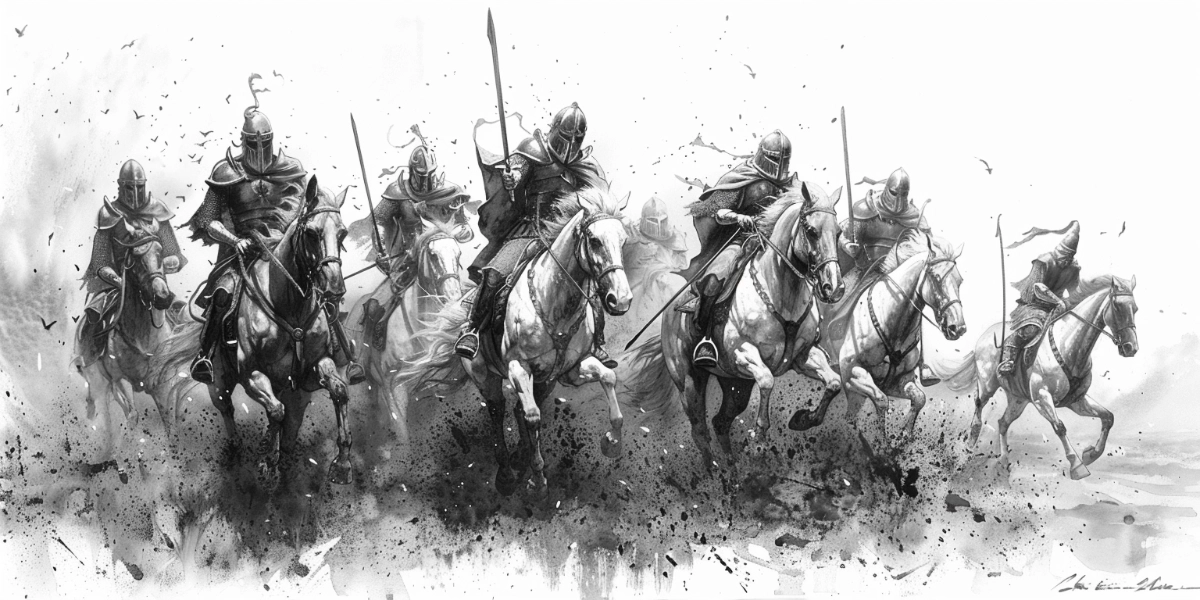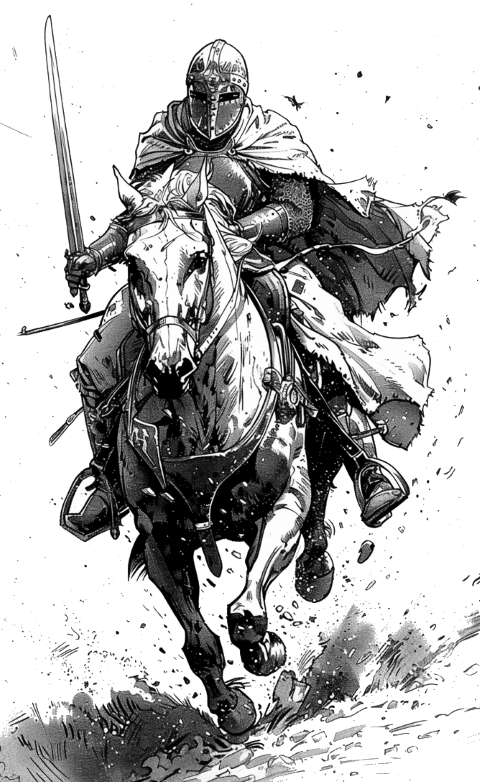
Mounted Combat in Shadowdark TTRPG
Streamlined Shadowdark mount rules: melee bonus, charging with polearms, risks of bolting, gear and barding, mounts and costs, plus travel flavor.
Greetings, brave crawlers! Whether you're charging into battle, making daring escapes, or simply looking for a reliable way to haul your hard-earned loot, mounts are an essential part of any fantasy adventurer's toolkit. They add a thrilling dimension to gameplay, especially during overland adventures where a simple yet engaging mounted combat system can elevate the excitement of your Shadowdark game.
In the spirit of Shadowdark's minimalist yet evocative style, I've crafted these concise rules for mounted combat and travel. They're designed to seamlessly integrate with the Shadowdark TTRPG, offering a brief but descriptive framework that expands your options without bogging down gameplay. These mounted combat rules are part of a larger project, where I'm compiling various travel-related mechanics. In addition to what you'll find here, I've posted some rules for hebs & foraging, and will be writing some rules on setting up camps, and interactive travel. The goal is to create a comprehensive supplement that enriches your overland adventures in the Shadowdark universe.
I'm excited to share these rules with you and eager to hear your thoughts! Please reach out to me on X (Twitter) to share your feedback, experiences, or suggestions. I'm also in the Shadowdark Discord, so hit me up there. Your input is invaluable as we continue to expand and refine the Shadowdark experience.
The Power of a Trusty Steed#
Crawling in Shadowdark is dangerous buisness, but it's not always delving underground. A reliable mount can be the difference between glory and a cold, lonely grave in the dark forests and dangerous countryside. But how exactly do these majestic beasts enhance your combat prowess? Let's break it down.
When you're astride your mount, you gain a +1 bonus to hit with melee weapons. It's amazing what a little extra height can do for your swing!
Charge!#
Wielding a polearm atop a charging mount? Add your mount's Strength modifier to your damage. This devastating move requires a straight charge of at least Near distance.
But beware, brave rider! This tactic cuts both ways. If you're on the receiving end of a charging foe while wielding a polearm, you can add the enemy mount's Strength modifier to your damage to an attack on any rider that has charged you. It's a high-risk, high-reward situation!
Mounted Movement#
When mounted, you use your trusty steed's movement as your own. This can significantly increase your tactical options on the battlefield or help you outrun that pesky goblin that's been tailing you... Let's just hope they don't have shortbows.
The Perils of Riding#
However, mounted combat isn't all glory and triumph. There are risks to consider:
Bolting: If your mount gets spooked (either by fright or by taking half its hit points in damage), you'll need to make a Morale check. Fail, and your mount bolts, carrying you away from the fray—whether you like it or not!
Staying Ahorse: When your mount rears or stumbles, you'll need to make a hard Strength check to avoid being thrown. No proper saddle? You're rolling with disadvantage, cowboy.
Unseating a Rider: Enemies can try to knock you off your high horse with a contested Strength check. You get advantage on your roll, but if you fail, it's a long way down.
Burdens: Carry Capacity of Mounts#
Mounts are not just for riding; they're excellent pack animals too:
- Riderless mounts can carry triple the normal Gear Slots.
- Mounts with riders use standard Gear Slots.
(For more details on Gear Slots, check out page 35 of the Shadowdark rulebook.)
Meet the Mounts#

Horses are the most common mount or pack animal in most setting, but by no means the only. In addition to the normal riding Horse presented on p227 in the Shadowdark TTRPG, here are a few more options for your adventurer.
Pony/Mule#
The Crawler's Trusty Companion. Neutral
- AC 12
- HP 11, LV 2
- ATK hooves +2 (1d6)
- MV Double Near, AL N
|S: +2|D: +2|C: +2|I: -3|W: +1|C: -2|
Surefooted. ADV on any roll to avoid tripping or falling.
Stout. (Mules only) Mules carry quadruple their normal Gear Slots when riderless.
War Horse#
Bred for battle and Fury. Neutral
- AC 12
- HP 16, LV 3
- ATK: hooves +4 (1d8)
- MV Double Near
|S: +4|D: +2|C: +3|I: -3|W: +1|C: -2|
Fearless. ADV on Morale checks.
Fury. Attack with hooves during rider’s turn.
Gearing Up Your Mount#
Mounts require a bit of gear and care. Tack is generally required to ride or guide a mount, and all actions are at disadvantage without it. Barding is available to safeguard your mount in battle, but only War horses can wear Chain or Plate. While most mounts can forage in a normal or wooded environment, they'll need Feed to gain the benefits of a rest.
| Gear | Cost | Slots |
|---|---|---|
| Tack (Saddle, stirrups, bridle, halter, rein, bit, and harness) | 15 gp | 2 |
| Barding (Leather, Chain, or Plate armor) | 4x | 2x |
| Feed (3 days) | 2 sp | 1 |
Buying a Mount#
| Mount | Cost |
|---|---|
| Horse | 100 gp |
| Mule | 25 gp |
| Pony | 20 gp |
| War Horse | 300 gp |
Adding Flavor: Mount Coats#
Want to make your mount stand out? Roll a d10 and consult this table for your mount's coat color:
| d10 | Coat Color | Description |
|---|---|---|
| 1 | Midnight Black | A deep, lustrous black that seems to absorb light. Often associated with mysterious or powerful mounts. |
| 2 | Chestnut Brown | A rich, warm brown color reminiscent of polished wood. Common among sturdy, reliable steeds. |
| 3 | Dapple Gray | A mesmerizing pattern of dark spots on a light gray background, creating a cloudy effect. Often seen on elegant, mature horses. |
| 4 | Pure White | A brilliant, unblemished white coat that seems to glow. Rare and often associated with noble or magical mounts. |
| 5 | Golden Palomino | A shimmering golden body color with a white mane and tail. Prized for their beauty and often favored by nobles. |
| 6 | Roan | A striking mix of red-brown and white hairs, creating a speckled appearance. Known for their hardy nature. |
| 7 | Bay | A classic look with a red-brown body and black mane, tail, and lower legs. Versatile and common among various breeds. |
| 8 | Pinto | Dramatic large patches of white and dark colors (often black, brown, or chestnut). Each pattern is unique, like a living canvas. |
| 9 | Buckskin | A golden tan body with black mane, tail, and lower legs. Often associated with tough, enduring mounts of the frontier. |
| 10 | Appaloosa | Distinctive spotted pattern, often with a white or light-colored body covered in dark spots. Historically bred by the Nez Perce people and known for their intelligence and stamina. |
So there you have it, brave adventurers! With these rules, you're ready to thunder across the battlefield, charge down your foes, and explore the far reaches of your Shadowdark world on horseback. Remember, a well-trained mount is more than just a means of transportation—it's a loyal companion and a formidable weapon in the right hands.
Now, saddle up and ride forth to glory! May your steeds be swift, your aim be true, and your shadows less... er... darkly!
Anyway, let me know what you think!
Drop a comment on X and let me know your thoughts!